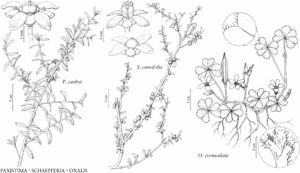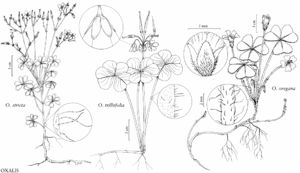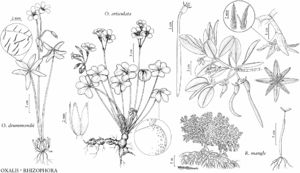Oxalis
Sp. Pl. 1: 433. 1753.
Herbs [subshrubs, shrubs, or vines], caudex absent (present in O. dichondrifolia, O. frutescens, O. montana, and O. texana), usually with tubers, bulbs, or rhizomes, sometimes fibrous-rooted or taprooted. Aerial stems erect to decumbent, prostrate, or creeping, or absent. Leaves basal or cauline, palmately compound (pinnately compound in O. frutescens, 1-foliolate in O. dichondrifolia); leaflets pulvinate, usually 2-lobed, sometimes not lobed, often deflexed and folded together at night, laminae and margins often with black or orange oxalate dots or stripes. Flowers tristylous, distylous, semihomostylous (one whorl of anthers at level of stigmas, other proximal or distal), or homostylous (all anthers at level of stigmas); petals yellow, white, pink, salmon, red, lavender, purple, or violet; stamens: filaments 5 long and 5 short, alternating with one another, or equal length. x = (5–) 7 (–12).
Distribution
North America, Mexico, West Indies, Central America, South America, Eurasia, Africa, Atlantic Islands, Indian Ocean Islands, Pacific Islands, Australia, in Bermuda
Discussion
Species ca. 700 (36 in the flora).
Species of Oxalis occur in the tropics and subtropics, mostly of North America, South America, and South Africa; they extend as well into temperate regions of North America, Europe, and Asia. The largest numbers of species are in South America and South Africa. Many species are cultivated as ornamentals because of their showy flowers and leaf diversity, and at least 100 species are offered for sale via the Internet. They are usually grown as container plants and need sun for flowering.
Oxalate deposits, usually as orange or blackish dots or stripes, sometimes are produced on the leaf lamina and along the margins and on the sepal apices. Their arrangement, especially on the leaves, usually is characteristic of a species.
The stipules of some caulescent species are characterized here as rudimentary; they are completely or nearly completely adnate to the petiole base and appear only as a thickened, more or less broadly oblong region, perhaps suggestive of a pulvinus.
Canadian distributions below are based on VASCAN (http://data.canadensys.net/vascan); not all have been verified for this treatment.
Selected References
Lower Taxa
Key
| 1 | Leaflets 1. | Oxalis dichondrifolia |
| 1 | Leaflets 3–11. | > 2 |
| 2 | Leaves basal; plants acaulous. | > 3 |
| 3 | Petals deep golden yellow. | Oxalis pes-caprae |
| 3 | Petals white to pink, salmon, red, lavender, purple, or violet, sometimes yellow or greenish yellow basally or proximally. | > 4 |
| 4 | Rhizomes present; bulbs or bulblets present or absent. | > 5 |
| 5 | Leaflets dark purple, often with lighter violet splotches radiating from midvein adaxially, lobes apically truncate to slightly convex; rhizomes short, branching, covered with thickened, overlapping scales. | Oxalis triangularis |
| 5 | Leaflets usually green, sometimes purplish to deep purple abaxially, lobes apically convex or leaflets not lobed; rhizomes woody and irregularly nodulate-segmented, or fleshy-thickened. | > 6 |
| 6 | Sepal apices with 2 orange tubercles; rhizomes thick, woody, irregularly nodulate-segmented, often with persistent, thickened, woody petiole bases. | Oxalis articulata |
| 6 | Sepal apices without tubercles; rhizomes slender or fleshy-thickened, sparsely or densely scaly or nonscaly. | > 7 |
| 7 | Bulbs or bulblets present; rhizomes slender or thickened, sparsely scaly. | > 8 |
| 8 | Inflorescences 1-flowered; scapes 1.5–6(–8) cm, sparsely to moderately villous (hairs eglandular); bulbs 1–2.5 cm or plants with clustered bulblets; leaflets not lobed. | Oxalis purpurea |
| 8 | Inflorescences 4–12-flowered; scapes 15–20 cm, densely glandular-puberulent; bulbs 2–4 cm; leaflets lobed. | Oxalis bowiei |
| 7 | Bulbs or bulblets absent; rhizomes fleshy-thickened, densely scaly. | > 9 |
| 9 | Inflorescences 2–9(–15)-flowered; petals white to pinkish, sometimes greenish proximally, without prominent veins; capsules narrowly fusiform, 15–25(–30) mm. | Oxalis trilliifolia |
| 9 | Inflorescences 1-flowered; petals white to deep pink, usually with yellow spot sub-basally and rose colored or purple veins; capsules subglobose to ovoid, 2–8(–12) mm. | > 10 |
| 10 | Scapes 4–15 cm; petals 10–15 mm; capsules 2–4 mm; e North America. | Oxalis montana |
| 10 | Scapes (6–)11–25 cm; petals (8–)15–25 mm; capsules 6–8(–12) mm; w North America. | Oxalis oregana |
| 4 | Rhizomes absent (rarely present in O. violacea, where slender, scaly, bearing bulblets at tips); bulbs or bulblets present. | > 11 |
| 11 | Leaflets (3–)4–11. | > 12 |
| 12 | Leaflets (3–)4(–5), obtriangular to obcordate, 5–22 mm, lobed 1/5–1/2 length; bulb scales (3–)5–7-nerved. | Oxalis caerulea |
| 12 | Leaflets (3–)5–11, narrowly oblong-oblanceolate to narrowly oblong or linear, (10–)12–38(–72) mm, lobed (1/6–)1/2–2/3(–9/10) length; bulb scales 9–15+-nerved. | Oxalis decaphylla |
| 11 | Leaflets 3. | > 13 |
| 13 | Leaflets: oxalate deposits in dots at least around distal margins, often evenly over surface, abaxial surfaces hirsute. | Oxalis debilis |
| 13 | Leaflets: oxalate deposits absent or in band or lines along margins at base of notch, abaxial surfaces glabrous, strigose, or hirsute-strigose, sometimes densely hirsute at very base. | > 14 |
| 14 | Leaflets obtriangular to broadly obtriangular, lobes apically truncate; stolons often present, with bulblets at tips; bulbs usually clustered, sometimes solitary. | Oxalis intermedia |
| 14 | Leaflets obtriangular to obcordate, rounded-obcordate, obreniform, or obdeltate, lobes apically rounded to convex or nearly truncate; stolons absent; bulbs solitary or clustered. | > 15 |
| 15 | Petals with dark purple veins proximally; leaflet abaxial surfaces strigose to hirsute-strigose, sometimes densely hirsute at very base. | > 16 |
| 16 | Leaflet abaxial surfaces strigose to hirsute-strigose, densely hirsute at very base, margins prominently ciliate with stiff, sharp-pointed hairs; outer bulb scales 3[–5]-nerved; sepal apices with 2 elongate, orange tubercles. | Oxalis hispidula |
| 16 | Leaflet abaxial surfaces sparsely but evenly strigose with fine hairs, margins glabrous to sparsely irregularly ciliate with loose, fine hairs; outer bulb scales 5–8[–13]-nerved; sepal apices without tubercles. | Oxalis brasiliensis |
| 15 | Petals with green veins proximally; leaflet abaxial surfaces glabrous. | > 17 |
| 17 | Bulbs usually surrounded by cluster of bulblets; leaflets: oxalate deposits usually in narrow band 0.5–1.5 mm along margins at base of notch, sometimes evident on one surface but not other, rarely apparently absent. | Oxalis metcalfei |
| 17 | Bulbs solitary, bulblets absent or rarely at tips of rhizomes; leaflets: oxalate deposits absent or in lines along margins at base of notch. | > 18 |
| 18 | Bulb scales (5–)7–9(–11)-nerved; sepal apices with tubercles not confluent; sw United States. | Oxalis latifolia |
| 18 | Bulb scales 3-nerved; sepal apices with tubercles apically confluent; primarily e and s central United States. | > 19 |
| 19 | Leaflets obtriangular to obcordate, (6–)14–34 mm, oxalate deposits absent. | Oxalis drummondii |
| 19 | Leaflets rounded-obcordate to obreniform, (5–)8–15(–20) mm, oxalate deposits in lines along margins at base of notch. | Oxalis violacea |
| 2 | Leaves cauline or basal and cauline; plants caulescent. | > 20 |
| 20 | Petals white to pink, rosy purple, or pinkish purple. | > 21 |
| 21 | Petioles 0–0.2 cm; stems villous; leaflets linear to narrowly oblanceolate or oblong-cuneate, not lobed, abaxial surfaces villous; axillary bulblets absent; petals rosy purple to pink or white. | Oxalis hirta |
| 21 | Petioles 2–5(–7) cm; stems glabrous; leaflets obcordate, lobed 1/4 length, abaxial surfaces glabrous; axillary bulblets often present; petals white to pale pinkish purple. | Oxalis incarnata |
| 20 | Petals yellow, sometimes with red lines. | > 22 |
| 22 | Leaves pinnately compound (terminal leaflets on extended petiolules); leaflets cuneate to obovate or oblong-obovate, not lobed. | Oxalis frutescens |
| 22 | Leaves palmately compound; leaflets obcordate, lobed 1/5–1/3 length. | > 23 |
| 23 | Inflorescences racemes; plants annual; capsules 3–5 mm. | Oxalis laxa |
| 23 | Inflorescences cymes; plants perennial (annual in O. corniculata, sometimes annual in O. stricta); capsules 6–20(–25) mm. | > 24 |
| 24 | West of the Mississippi River. | > 25 |
| 25 | Stipule margins with wide, free flanges, apical auricles free; stems prostrate or decumbent, often rooting at nodes; rhizomes absent. | Oxalis corniculata |
| 25 | Stipules rudimentary or margins narrowly to very narrowly flanged or without free portions, apical auricles slightly free or absent; stems erect, ascending, decumbent, or prostrate, rooting at nodes or not; rhizomes present or absent. | > 26 |
| 26 | Stems villous; petioles, and usually stems, with septate and nonseptate hairs; rhizomes present; stems 1(–3) from base. | > 27 |
| 27 | Petals (6–)8–11 mm; inflorescences (1–)5–7(–15)-flowered, regular or irregular cymes; stems 20–60(–90) cm; rhizomes short. | Oxalis stricta |
| 27 | Petals 12–20 mm; inflorescences 1–3-flowered, umbelliform cymes; stems 10–25 cm; rhizomes long. | Oxalis suksdorfii |
| 26 | Stems usually strigose, strigillose, puberulent, hirtellous-puberulent, pilose, rarely villous proximally (O. florida, O. texana), or glabrous; petioles and stems glabrous or with nonseptate hairs; rhizomes present or absent; stems (1–)2–8 from base (usually 1 in O. florida). | > 28 |
| 28 | Stems usually strigillose or strigose, hairs straight, antrorsely appressed to closely ascending, Louisiana plants rarely villous proximally, hairs spreading. | > 29 |
| 29 | Inflorescences 1–3(–8)-flowered; flowers mostly homostylous; petals without red lines, (2.5–)4–8 mm. | Oxalis dillenii |
| 29 | Inflorescences (2–)3–5(–8)-flowered; flowers distylous; petals with prominent red lines proximally, (10–)12–16(–17) mm. | Oxalis texana |
| 28 | Stems glabrous or puberulent, hirtellous-puberulent, pilose, or sparsely to moderately strigose, hairs curved or crisped, or, if straight, spreading. | > 30 |
| 30 | Sepals glabrous. | > 31 |
| 31 | Stems usually glabrate to sparsely or moderately strigose, sometimes sparsely villous proximally; stipules rudimentary; inflorescences 1–2(–3)-flowered; Arkansas, Louisiana, Missouri, Texas. | Oxalis florida |
| 31 | Stems glabrous or very sparsely short-puberulent; stipules oblong; inflorescences 1(–3)-flowered; Arizona, California. | Oxalis californica |
| 30 | Sepals strigose to hirsute-strigose. | > 32 |
| 32 | Stems puberulent to hirtellous-puberulent, hairs usually antrorsely curved or crisped, sometimes ± straight, longer hairs 0.2–0.3(–0.8) mm. | Oxalis albicans |
| 32 | Stems sparsely to densely pilose, hairs spreading irregularly to ± deflexed, longer hairs 0.6–1.2 mm. | Oxalis pilosa |
| 24 | East of the Mississippi River. | > 33 |
| 33 | Stems prostrate or decumbent, rooting at nodes; rhizomes and stolons absent; stipules oblong, margins with wide, free flanges, apical auricles free; seeds brown, transverse ridges brown. | Oxalis corniculata |
| 33 | Stems erect to ascending, sometimes decumbent, rarely rooting at nodes; rhizomes or stolons usually present; stipules rudimentary or apparently absent, or, if oblong, margins narrowly to very narrowly flanged or without free portions, apical auricles slightly free or absent; seeds brown to blackish brown, transverse ridges brown, white, or with grayish or white lines. | > 34 |
| 34 | Stems strigose or strigillose, hairs straight, antrorsely appressed to closely ascending (central Louisiana populations of O. texana rarely irregularly villous proximally). | > 35 |
| 35 | Inflorescences 1–3(–8)-flowered; flowers mostly homostylous; petals (2.5–)4–8 mm, without red lines. | Oxalis dillenii |
| 35 | Inflorescences (2–)3–5(–8)-flowered; flowers distylous; petals 11–15 mm (Arkansas, Louisiana, Texas) or 6–12 mm (Alabama), with red lines proximally. | Oxalis texana |
| 34 | Stems glabrate or villous-hirsute, hirsute-pilose, pilose, villous, or strigose, hairs ± straight or slightly curved (if stems strigose), spreading, deflexed, or antrorse. | > 36 |
| 36 | Stems usually sparsely to moderately strigose or glabrate distally, sometimes sparsely villous proximally, hairs slightly curved, antrorse; petals 4–8 mm. | Oxalis florida |
| 36 | Stems villous, villous-hirsute, hirsute-pilose, or pilose, sometimes glabrate on at least proximal 2/3, hairs curved or ± straight, spreading or deflexed; petals (6–)8–20(–23) mm. | > 37 |
| 37 | Petioles and stems with nonseptate hairs; inflorescences umbelliform cymes; flowers well above level of leaves. | > 38 |
| 38 | Petals (13–)15–20(–23) mm; pedicels villous, hairs long, spreading; capsules sparsely to densely hirsute-pilose, hairs long; plants strongly colonial; limestone and chalk habitats. | Oxalis macrantha |
| 38 | Petals 9–15 mm; pedicels strigose, hairs short, curved antrorsely; capsules glabrate to puberulent or sparsely hirsute-strigose, hairs short; plants cespitose or weakly colonial; wide variety of habitats, including limestone. | Oxalis colorea |
| 37 | Petioles, and usually stems, with septate and nonseptate hairs; inflorescences regular, irregular, or umbelliform cymes; flowers above or at level of leaves. | > 39 |
| 39 | Petals (6–)8–11 mm; inflorescences (1–)5–7(–15)-flowered. | Oxalis stricta |
| 39 | Petals 10–18 mm; inflorescences 1–4(–8)-flowered. | > 40 |
| 40 | Petals 10–14 mm, with or without faint red lines proximally; rhizomes becoming woody, without tubers; leaflet lobes apically usually rounded, rarely ± truncate, margins green or brownish purple; flowers above level of leaves. | Oxalis grandis |
| 40 | Petals 12–18 mm, with prominent red lines proximally; rhizomes herbaceous, with tubers or tuberlike thickenings; leaflet lobes apically truncate, margins green; flowers mostly at level of leaves. | Oxalis illinoensis |
"alternating" is not a number.


